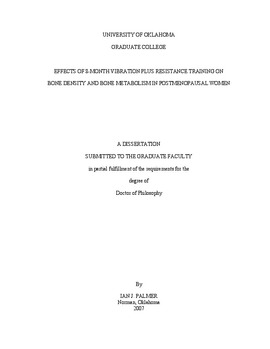| dc.contributor.advisor | Bemben, Debra A., | en_US |
| dc.contributor.author | Palmer, Ian J. | en_US |
| dc.date.accessioned | 2013-08-16T12:20:50Z | |
| dc.date.available | 2013-08-16T12:20:50Z | |
| dc.date.issued | 2007 | en_US |
| dc.identifier.uri | https://hdl.handle.net/11244/1225 | |
| dc.description.abstract | Introduction. Whole body vibration has been shown to be osteogenic in animal models; however its application in humans is not clear. | en_US |
| dc.description.abstract | Purpose. The purpose of this study was to examine the effects of an eight month program involving vibration plus resistance training on bone mineral density (BMD) and bone metabolism of older postmenopausal women. | en_US |
| dc.description.abstract | Results. At baseline, there were no group differences in age, height, weight, calcium intake, strength, BMD, or BMC. Two-way repeated measures ANOVA (group x time) did not detect significant group or time effects for BAP, CTX, or BMD of the total body, spine, left hip (total hip, trochanter, femoral neck), or right trochanter. A significant (p< 0.05) time effect revealed a decrease in right total hip and right femoral neck BMD. A group x time interaction (p< 0.05) was detected at the forearm, with C slightly increasing, VR slightly decreasing, and R remaining the same. Repeated measures ANOVA (group X time) revealed a significant (p< 0.01) main effect and interaction effect for 1RM of the 8 tested exercises. R and VR significantly (p< 0.05) increased 1RM strength in 5 exercises, compared with C. ANOVA determined significant (p< 0.01) group differences in pre-post percent (%) change in strength. VR had significantly (p< 0.05) higher relative strength increases in 5 of the eight exercises, compared with R. Ranges in %change were 42-138% among VR and 23-88% among R. | en_US |
| dc.description.abstract | Conclusions. No significant alterations in bone biomarkers, BMD, or BMC were detected. Although there were significant increases muscle strength, no benefits for skeletal health were evident. | en_US |
| dc.description.abstract | Methods. Fifty-five women were assigned to a resistance training group (R, n=22), a vibration plus resistance training group (VR, n=21), or a control group (C, n=12). R and VR trained 3 days/week for 8 months on 8 exercises. VR received vibration (30-40Hz, 2-2.8g) in three different positions preceding resistance exercise. Training loads were adjusted every 5 weeks. Daily calcium intake; biochemical markers of bone turnover, bone-specific alkaline phosphatase (BAP) and C-telopeptide of Type I collagen (CTX); and BMD and bone mineral content (BMC) of the spine, dual femur, forearm, and total body (DXA) were measured at baseline and month 8. | en_US |
| dc.format.extent | x, 211 leaves : | en_US |
| dc.subject | Exercise for women Oklahoma Oklahoma City. | en_US |
| dc.subject | Older women Diseases Oklahoma Oklahoma City. | en_US |
| dc.subject | Bone densitometry. | en_US |
| dc.subject | Calcium in the body. | en_US |
| dc.subject | Vibration Therapeutic use | en_US |
| dc.subject | Health Sciences, Recreation. | en_US |
| dc.title | Effects of 8-month vibration plus resistance training on bone density and bone metabolism in postmenopausal women. | en_US |
| dc.type | Thesis | en_US |
| dc.thesis.degree | Ph.D. | en_US |
| dc.thesis.degreeDiscipline | Department of Health and Exercise Science | en_US |
| dc.note | Adviser: Debra A. Bemben. | en_US |
| dc.note | Source: Dissertation Abstracts International, Volume: 68-05, Section: B, page: 3000. | en_US |
| ou.identifier | (UMI)AAI3264593 | en_US |
| ou.group | College of Arts and Sciences::Department of Health and Exercise Science | |
